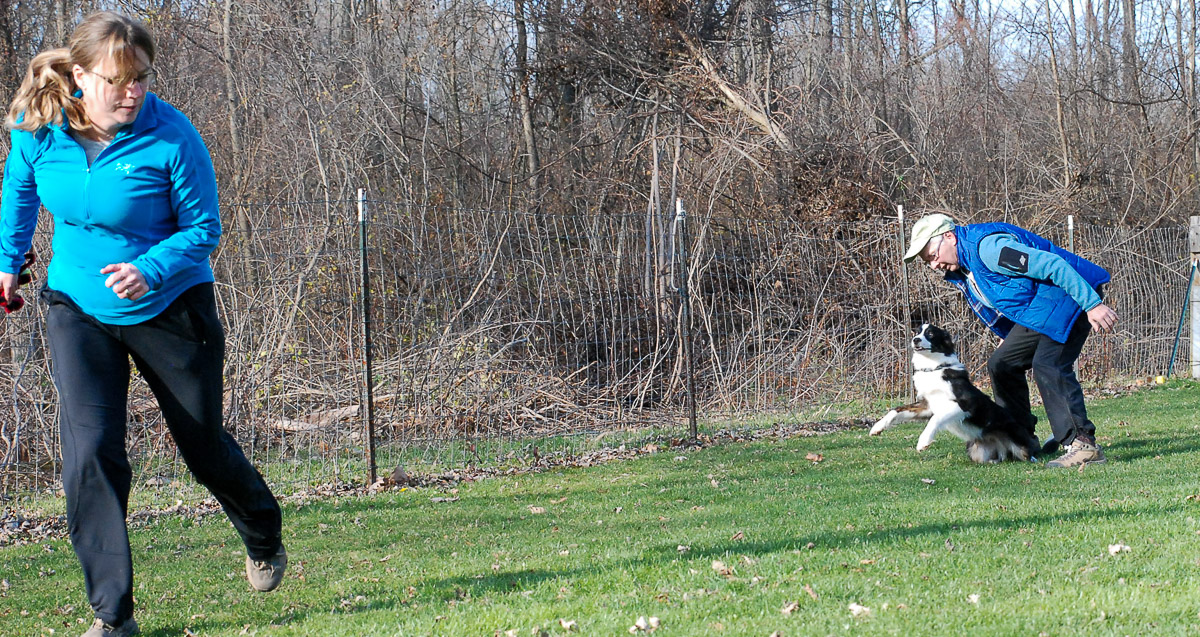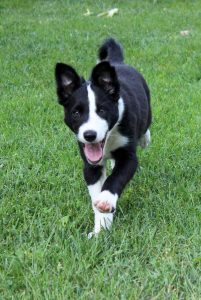
Recalls!
This is the second in a series of posts that explore the “little things” that lead to big improvements in agility AND your relationship with your dog.
Everyone understands the importance of recalls in training a puppy. I’m going to make the case in this article that recalls build a great relationship with your dog AND can be a strategic part of your agility training throughout the dog’s career.
Puppy recalls
Why is recall training so important? It teaches the puppy its name, builds a solid foundation for your relationship, develops pack behavior and it encourages the puppy to follow you.
Practicing recalls with a young puppy teaches it that coming to you results in very good things – cookies, toy play, praise, petting. The value of an instant response when the puppy hears its name are many…the most important being safety – think of a dog running toward a busy road. And in everyday life, a great recall is worth its weight in gold.
The perfect recall – that we all strive for! – means that the puppy will come when you call its name (or other cue that you have established) regardless of distraction. It’s another VERBAL CUE that should be taught deliberately, thoroughly proofed and protected!
When approaching your recall training:
Be Deliberate: Include specific recall training in your daily time spent with the puppy.
Build on Good Choices: Allow the puppy to CHOOSE to come to you. My rule of thumb is to give my puppy enough freedom to allow for choices but limit the choices so that there is a very good chance of success and of course, keep the puppy safe.
Be Strategic: Gradually and strategically introduce recall training in different environments and with varied distractions. I raise my chance of success by controlling the environment and level of distraction. Examples of controlling the environment are indoor spaces, fenced outdoor spaces, leashes, long lines, etc. I want my puppy to be rewarded for good choices so I limit his options appropriate for the stage of his training.
Protect the Verbal Recall Cue: I have one ironclad rule in training my puppy’s recall…I only call the puppy’s NAME (my recall cue) when I am 90%+ sure he will come! If my 9 week old puppy is having playtime and is fully engaged with another puppy, I’m not going to call the puppy. If my 16 week old puppy is in the same situation, I might get in close and call him. But if I call once and the puppy doesn’t come, I DO NOT call again. I move closer, use my generic “pup-pup” word, might gently tap the puppy’s butt to get his attention or hold a cookie near his ear, then say his name. I might call “pup-pup” and run away to get a chase response. When the puppy CHOOSES to respond, that response gets an immediate mark (yes or click) and reward. Why not call the name more than once? This is very important! If I say the dog’s name over and over again and he doesn’t respond, I am teaching him to ignore me! The verbal cue of your dog’s name becomes meaningless. Note: This rule goes out the window if safety is involved!
When practicing recalls, only call your puppy ONCE and mark the CHOICE the puppy has made to come to you.
I am not going to go into detail about all the recall games I play with my puppies because there are tons of online resources on this topic. Instead, I want to draw the dots between this early training and success in other aspects of your future agility star.

Recalls for Agility and Life
I incorporate a lot of chase games into my recall training. Running away after calling the puppy’s name (or release cue) builds drive to come to me quickly. I look over my shoulder as I move away and reward the puppy when he catches up helping him learn to come up on the side that is facing him. This is the beginning of my agility handling training!
It’s a good idea to hold your reward in the opposite hand, like Barb is doing, so that the dog is coming to YOU, not a dangling toy or obvious food reward. Switch the reward to the dog-side hand as the dog reaches you.
What I do when the puppy gets to me on the recall is used to introduce important concepts of agility handling. Essentially, I want my puppy to learn: 1) Always come up on the side that is facing you 2) When I run, you run; 3) When I stop, you stop; 4) When I turn, you turn. These types of lessons are perfect for restrained recalls (where another person holds the puppy) and the puppy is released on the call of its name, not the release cue. As the puppy matures and develops impulse control, the recalls can start with a stationary behavior (sit, down, stand) and the use of a separate release cue (see the first post in this series).
I bucket my recalls like this:
When I run, you run (acceleration): Lead out in “game on” position (like Barb is doing in the picture above). Release and start running. Throw the reward ahead in a straight line as the dog gets near me. The puppy has learned that as long as I keep running he should too. The verbal “GO” can be added into this recall.
When I stop, you stop (deceleration): Lead out in “stationary” position. Release the puppy and stand still. Reward when the puppy reaches me. The puppy has learned that he should “dig in” and stop when I am stationary. There are several variations of this type of stationary recall, including running first and then stopping. I can either be facing in the same direction of the puppy or I can turn and face the puppy. The verbal collection cue (e.g. “dig-dig”) can be added into this recall.
When I turn, you turn: Lead out in “game on” position. Release and start running. As the puppy gets near me, I turn away from the puppy, tapping my leg to keep the puppy on the recall side and saying his name (or bypass cue) to keep him with me. Effectively executing a post turn or teaching the beginning of a bypass cue.
Come up on the new side: Lead out in “game on” position. Release and start running. As the puppy gets near me, I turn into the puppy, effectively executing a front cross. Or, way before the puppy reaches me, I turn away from the puppy and present a new side, effectively executing a blind cross.
With these recalls, I have taught the puppy all the handling elements that he will respond to on course! For some of these recalls, there is more foundation work separate from the recalls, like teaching the dog about reinforcement zone and working separately on circle work. But that is for another post. All of these recalls can be adapted to either wing work or one/two jump work as your dog progresses.
Revisit these recalls throughout the dog’s career as a great way to reinforce early lessons and warm up both you and your dog.
The main message of this post is to FREQUENTLY revisit your recalls throughout your dog’s career. You will continue to put value into your relationship, your dog’s response to your most basic handling cues and practice your stays. What better way to warm-up both you and your dog before training than to strategically practice your recalls (and circle work)? Make it a habit and you will keep your dog’s response to your acceleration, deceleration and turning cues sharp throughout his career.
